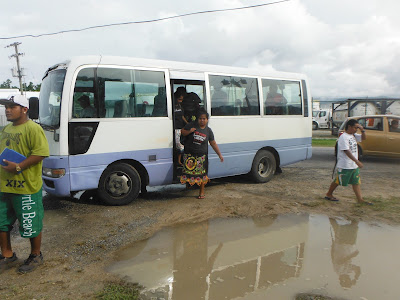Ethnobotany class visit to Vital Coconut Development Unit
The ethnobotany class studies the plants people use and how those plants are used. The unit on material cultural uses of plant products includes economic botany, economically valuable plants and their uses. The coconut tree is literally the tree of life and a tremendous natural resource. Federated States of Micronesia Public Law 18-68, the Coconut Tree Act of 2014, placed the former national Coconut Development Authority with Vital. Vital has been executing a mandate from the President of the FSM and the FM Congress with an eye toward rapidly developing the coconut sector in the FSM into a long-term sustainable economic activity. Source: Vital Transition of CDA: Phase I
Under this mandate Vital has set a number of goals. Vital plans to develop and upgrade domestic processing capacity of coconut.Vital will be able to process copra produced in the FSM into crude coconut oil for fuel, and coconut meal for animal feed. In a separate process Vital also continues to produce coconut oil for cooking, soap, and the production of body oil.
During this field trip the class learns about the development of the coconut oil industry in the FSM. Vital CDU purchases copra from the outer islands providing a critical source of income for outer islanders. The oil is then sold to retailers. Vital CDU is a wholesaler of oil.
100 pounds of copra will yield roughly 60 pounds of coconut oil
A conference began on Monday in Fiji to kick off the new Coconut Industry Development for the Pacific project. Coconut oil, used as coconut diesel, is a renewable energy resource and a potential future source of electric power for the islands. At present low prices for fossil fuels keeps coconut diesel from being competitive, but fossil fuel prices will one day rise again, and coconut diesel will provide a sustainable source of fuel for the island of the Pacific.
Bus arrival at 15:55
Under this mandate Vital has set a number of goals. Vital plans to develop and upgrade domestic processing capacity of coconut.Vital will be able to process copra produced in the FSM into crude coconut oil for fuel, and coconut meal for animal feed. In a separate process Vital also continues to produce coconut oil for cooking, soap, and the production of body oil.
During this field trip the class learns about the development of the coconut oil industry in the FSM. Vital CDU purchases copra from the outer islands providing a critical source of income for outer islanders. The oil is then sold to retailers. Vital CDU is a wholesaler of oil.
A grinder to grind the copra
The grinder output is then fed into a dryer
The dried ground copra is then sent into an expeller to remove oil
Jon Jovi and Dannia examine the output from the expeller
100 pounds of copra will yield roughly 60 pounds of coconut oil
Natasha looks at the expelled oil, Raydeen on the right
Eddie Parce explains the process of producing coconut diesel
One of the products produced is coconut shells which can then be sold as fuel or further processing into charcoal
The output of another dryer, one in the cosmetic and food oils production line. This smells wonderful: hot roasted coconut!
Siorine and Yostrick listen as the process is explained
Brandon, LynnJell, Raydeen, and Lienna at the oil expeller for cosmetic and food oil
Eddie explains the differences in the production of food and cosmetic oils to Joyleen David, Naoya, April, Georgene, and Brandon
Mary-Ann Henry stands on the weighing scale
Eddie continues his presentation on the processing of copra into oil and coconut oil products
Here Eddie shows the class the hand operated presses. No electricity required.
Some of the wholesale products from Vital CDU. Cosmetic oil, cooking oil, and soaps.
Soap is produced by reacting coconut oil with caustic soda, also known as lye or sodium hydroxide. The specific ratio chosen will yield either a basic laundry soap or a creamy beauty soap.
A final check of the role
Bus departure at 16:29
























Comments
Post a Comment